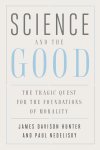Can science be the foundation of morality?
That is the question James Davison Hunter and Paul Nedelisky ask in Science and the Good. Their book traces the history of affirmative responses from the early modern period to the present day, focusing on the “new synthesis” that is comprised of four elements: “(1) a Humean mind-focused sentimentalism, (2) a Darwinian account of why the mind has the traits it does, (3) a human interested-based utilitarianism about morality, all embedded within (4) a strident naturalism committed to empirical study of the world.”
Anyone familiar with philosophy knows that sentimentalism, utilitarianism, and naturalism are contested theories. The question facing advocates of the new synthesis, then, is whether science tilts the playing field in favor of those theories. More specifically, does science provide “empirically observable” evidence in their favor? If not, it’s not clear precisely how science contributes to building the foundation of morality.
Hunter and Nedelisky point out that science might contribute to morality at three different levels: (1) “demonstrate with empirical confidence what, in fact, is good and bad, right and wrong, or how we should live”: (2) “give evidence for or against some moral claim or theory”; and/or (3) “provide scientifically based descriptions of, say, the origins of morality, or the specific way our capacity for moral judgment is physically embodied in our neural architecture, or whether human beings tend to behave in ways we consider moral.” Surveying the arguments new-synthesis advocates make, Hunter and Nedelisky conclude that “nearly all of the actual science attempting to deal with morality lands at Level Three findings.” This is a far cry from providing a foundation for morality, let alone of disposing of rival moral theories.
Worse, advocates of the new synthesis have moved the goal posts. Given its commitment to what Hunter and Nedelisky called “disenchanted naturalism,” the new synthesis no longer thinks of morality in terms of “moral realism,” i.e., that distinctions between right and wrong, good and bad, virtuous and vicious, refer to real, objective distinctions. Instead, those distinctions reflect individual preference or social consensus. The authors elaborate:
The quest [for a scientific foundation of morality] has been fundamentally redirected. The science of morality is no longer about discovering how we ought to live—though it is still often presented as such. Rather, it is now concerned with exploiting scientific and technological know-how in order to achieve practical goals grounded in whatever social consensus we can justify. The science of morality, then has evolved into an engineering project rooted in morally arbitrary goals.
The authors describe this as “moral nihilism,” which seems like an accurate description.
Science and the Good is a deeply researched, well-written book, and I have only scratched the surface of its argument against the new synthesis, which is detailed and complex. So, if science cannot provide a foundation of morality, what can? The authors eschew theological and natural-law arguments. Historically speaking, they argue, it was the failure of those types of arguments to prevent the European Wars of Religion in the post-Reformation Era that catalyzed the search for scientific arguments in the first place.
(I would like to register a demurral at this point. I think theological and natural-law arguments are stronger than Hunter and Nedelisky do. So, I’m not as convinced as the authors are that appeals to such arguments represents a dead end. Moreover, it’s not clear to me that the Wars of Religion were religious failures as much as they were a political failures. They resulted not so much from differences in religion but from desires for sovereignty. But those are arguments for another day.)
Instead of appealing to religion or natural law, Hunter and Nedelisky challenge the premise of the quest to provide a single foundation for morality in the first place—religious or scientific. “In both cases,” they write, “the effort represented different ways of achieving a foundation for a just and humane social order by denying, avoiding, or transcending the knotty, seemingly irreducible problem of difference.” That being the case, the way forward is “to find a common moral understanding throughour particularities—through our differences—and not in spite of them. Surely there are goods we can all affirm and corruptions we can all repudiate, despite coming from different perspectives.”
Hunter and Nedelisky voice this plaintive cry in the last five pages of the book. It is a hoped-for rather than an argued-for position, so not much can be said against it since not much was said for it in the first place. Regardless, in a pluralistic society, perhaps this plaintive cry is the most practical way forward. After all, we can agree that something is right or wrong even if we cannot agree on why it is so. But we can only find that agreement if we talk to one another across the divides—religious, ideological, partisan, etc.—that separate us.
 Book Reviewed
Book Reviewed
James Davison Hunter and Paul Nedelisky, Science and the Good: The Tragic Quest for the Foundations of Morality (New Haven, CT: Yale University Press, 2018).
P.S. If you liked my review, please click “Helpful” on my Amazon review page.

